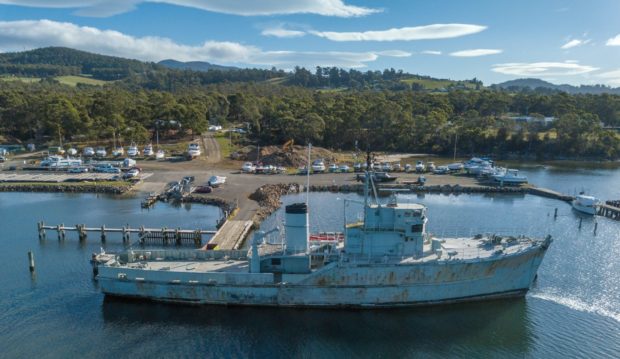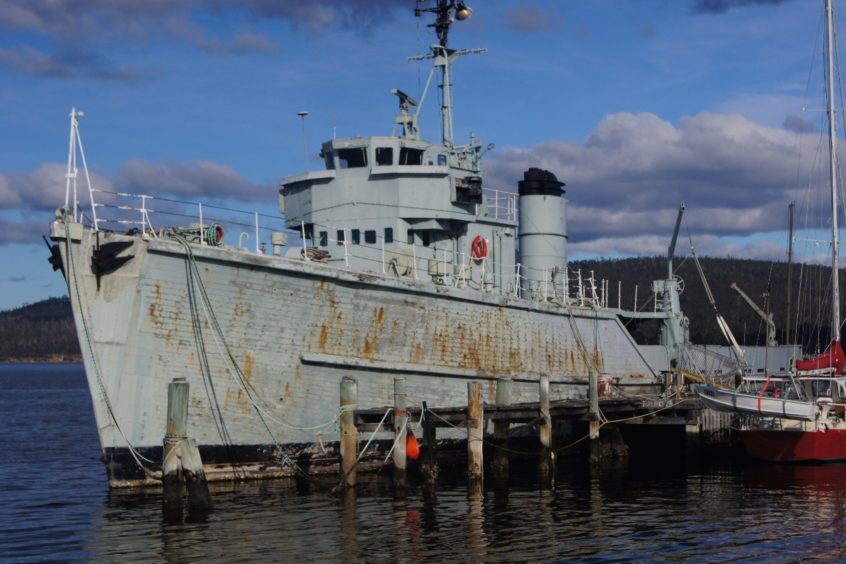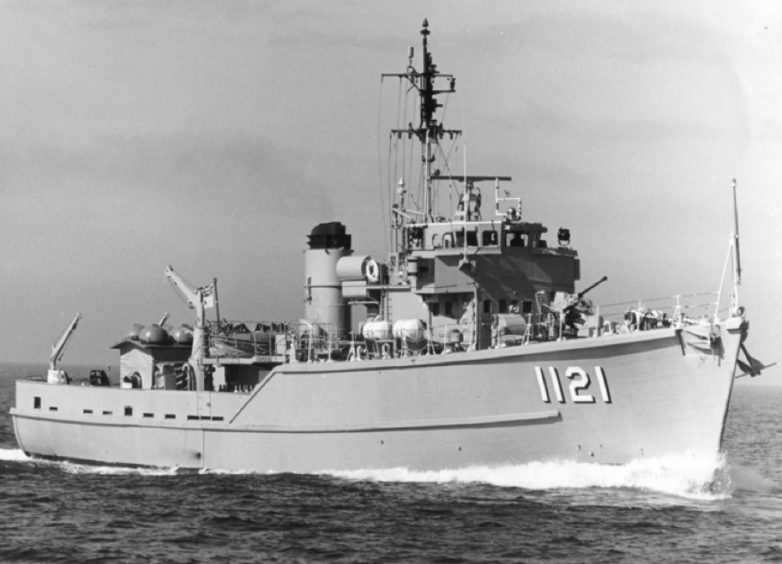She is the last surviving Ton Class mine-hunter in the world.
HMAS Curlew is an irreplaceable veteran of both the Royal and Royal Australian Navy.
Curlew was converted into Australia’s first mine-hunter in 1967 and served with the Royal Australian Navy for 28 years – being one of the first ships to respond to the Royal Australian Navy’s worst peacetime disaster in February 1964; providing aid in the aftermath of one of the most severe earthquakes in the history of Papua New Guinea in 1971; and helping Darwin get back on its feet after Cyclone Tracy in 1974.
She also apprehended an illegal Japanese fishing vessel and starred in segments of the Australian television series The Sullivans.
Curlew was also a star of the silver screen, appearing in 1997’s Paradise Road and 1998’s The Thin Red Line — and Hollywood royalty, including Glenn Close, have walked its decks.
Curlew had steamed more than 400,000 nautical miles in 40,000 hours before she was decommissioned in April 1990.
Without an owner
But the rusting hulk is now holding up a $20m marina development.
The second stage of the upgrade at Tasmania’s newest state-of-the-art boating complex at Margate Marina was recently completed with 133 berths constructed so far towards a target of 300.
Curlew is still afloat and moored at the marina but has been classified as unseaworthy by Marine and Safety Tasmania (MaST).
She is now without an owner after previously being purchased for $1 with the plan of turning it into a hostel for backpackers.
The wheelhouse has since been stripped and there is not one item on the boat which bears her name.
The hull is rotted and it would cost $3m to make her seaworthy.
The marina is big enough to host super yachts which have started to take their place.
The rusting Montrose hulk is an unwelcome sight and she will most probably be broken up and sunk.
Curlew was built in 1953 by Montrose Ship Building Company Ltd and was accepted into service with the Royal Navy as HMS Chediston.
She was renamed HMS Montrose and, from August 1955 to October 1957, was used by the Tay Division of the Royal Navy Volunteer Reserve.
Subsequently, she reverted to her former name and was placed in storage until she was one of six ex-Royal Navy Ton Class minesweepers purchased by the Royal Australian Navy (RAN) in the 1960s.
Her sister ships were HMA Ships Hawk, Gull, Snipe, Ibis and Teal and she arrived in Sydney with her sister ships in 1962.
After sea trials in early 1963 and a further refit at Garden Island Dockyard, Curlew rejoined the 16th MCM Squadron and sailed for her first overseas deployment.
Operation Gardening was a minesweeping task to clear a channel into Tonolei Harbour in Bougainville where US aircraft had dropped a large number of magnetic mines in 1943.
Worst peacetime disaster
This was the RAN’s biggest minesweeping operation for 16 years.
Curlew participated in mine countermeasures exercises in Australian waters from late January 1964 which were suspended briefly when she assisted in the search for survivors from the Melbourne/Voyager disaster.
The collision of HMAS Melbourne and HMAS Voyager remains the Royal Australian Navy’s worst peacetime disaster.
Occurring off the New South Wales coast in 1964, the aircraft carrier Melbourne and destroyer Voyager were engaged in night flying exercises when Voyager turned in front of Melbourne’s bow.
The destroyer was cut in half and sank with the loss of 82 men from a company of 314.
Curlew sailed for her first Far East Strategic Reserve (FESR) deployment in company with Snipe at the end of May to support anti-infiltration patrols in Malaysian waters.
She commenced her second FESR deployment in September 1965, again in company with Snipe, remaining deployed until the end of the Indonesian Confrontation in August 1966 that stemmed from Indonesia’s opposition to the creation of Malaysia.
Curlew decommissioned in 1966 for conversion into the RAN’s first minehunter.
Search for survivors
During August 1969, together with other RAN units, she was involved in a search for survivors from the merchant vessel, Noongah, which had foundered in heavy seas off Smoky Cape.
The MV Noongah departed Newcastle with a cargo of steel bound for Townsville but struck disastrous conditions off the coast of Smoky Cape.
Five survivors and one body were pulled from the water during the four-day massive air and sea search and rescue operation, but sadly 20 people were never found.
Curlew deployed to Papua New Guinea in company with Hawk and Snipe in late May 1971 to commence a Mine Warfare Pilotage Survey and South West Pacific deployment during which they provided aid in the aftermath of an earthquake.
The quake was believed to have been the most severe in the world since the devastating Alaskan earthquake of 1964.
She entered a seven month refit upon returning to Australia in November.
Following refit, Curlew commenced a Far East deployment in June 1972, in company with Snipe and Teal, during which they conducted general survey duties and cleared a Second World War minefield in the vicinity of Port Moresby.
During this deployment Curlew and Snipe were called upon to search the waters off Penang to locate the remains of a Royal Malaysian Air Force Sabre jet fighter which had crashed in the sea after the pilot had been forced to eject.
After an 11 hour search, Curlew located the wreckage of the aircraft in 32 feet of water.
Curlew once again deployed to Papua New Guinea in March 1975 in company with Ibis and Snipe, to contribute to Operation Still Dusty to clear mines laid by Australian forces during World War Two in Bootless Inlet, near Port Moresby, which now impeded the laying of a submarine telecommunications cable between Port Moresby and Cairns.
This was the largest mine-hunting operation by the RAN to date which involved the detection and clearing of mines from an area of 12 square kilometres by the end of April.
Cyclone Tracy
Curlew returned to Australian waters in May 1975 and commenced survey operations, most notably in the approaches to Darwin in the aftermath of Cyclone Tracy which killed 71 people and devastated 80 percent of the city.
During the month long operation, several sunken trawlers and other navigational hazards were located, most of them victims of the Cyclone, and whose fate had previously been unknown.
In addition to routine exercises and survey work during 1978, Curlew apprehended an illegal Japanese fishing vessel, Eikuku Maru No 71 in February, and starred in segments of the Australian television series The Sullivans.
She also assisted with the salvage of a Royal Australian Air Force (RAAF) F111 which had gone down off the New Zealand coast and ended the year as the winner of the Kelly Shield, the annual efficiency award for small ships in the RAN.
In February 1980, Curlew, Ibis and Snipe visited Tasmania to participate in festivities for the Hobart Regatta as well as undertaking mine countermeasures exercises including a team sweep along the northern Tasmanian coast.
This sweep of 90 miles in 40 hours was the longest sweep attempted since World War Two and was a record for RAN Ton Class MCMs.
Exercise Kangaroo 81
The trio followed this with a South West Pacific deployment from March to June which included visits to Port Moresby, Lombrum, Rabaul, Port Vila, Suva and Noumea, as well as exercises with the Papua New Guinean, Fijian and French navies.
Curlew participated in Exercise Kangaroo 81 in October/November 1981, at the conclusion of which she was tasked to survey the wreck of SS Trinity Bay in the vicinity of Cairns to recover unexploded ordnance from inside the vessel after it was sunk by RAAF jet fighters the previous week off Euston Reef after several attempts.
Curlew participated in the Fleet Concentration Period in February of 1983, followed by Exercise Sea Eagle 83 in February/March.
Upon completion Curlew and Ibis conducted mine warfare pilot surveys in Australian waters before deploying to South East Asia and conducting the first ever mine countermeasures exercises between Australian and Indonesian forces.
Oldest serving ship
In June 1983 Snipe was decommissioned making Curlew the oldest serving ship in the RAN celebrating 21 years of service.
Ibis paid off into the Reserve Fleet in May 1984, so when Curlew emerged from refit in June, she was the RAN’s only remaining MCM vessel.
Curlew spent the last six years of her service in Australian waters conducting exercises, survey work and participating in trials for the new minehunter inshore vessels.
During October 1985 she took part in a search for the wreckage of a jet freighter aircraft which had crashed into the sea off Sydney using her high definition sonar and Super Dart submersible.
In February 1989, Curlew became a training ship for sailors before she was decommissioned in April 1990 after 28 years of service and 38 years to the day after her keel had been laid.












